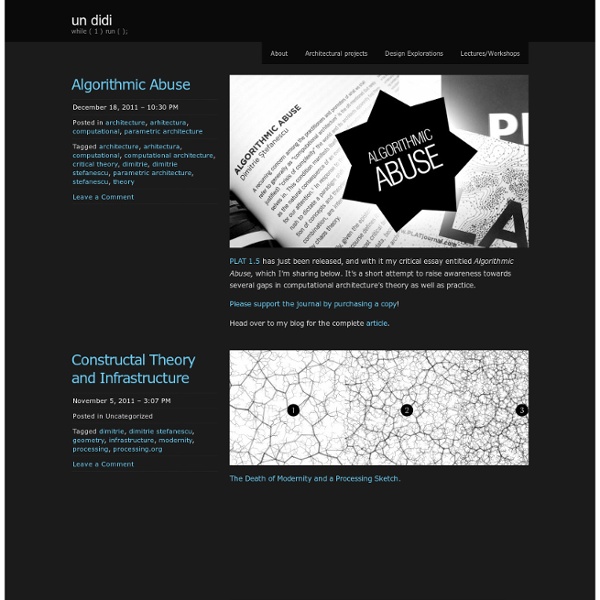



WooJae's Blog | architecture or something like that Curve to Surface « PARAMETRIC[ation] _ motion analysed - person walking up stairs There are three curves that were chosen to represent a person walking up a stairs; the motion of each of the legs and the motion of a person’s head. The curves from the legs overlap each other and skip a step each time while the curve from the head is a continuous one that moves in the same motion at each every step. By taking these curves and shifting the top curve down, I have chosen to develop a model that has two different surfaces defined by the head motion on the top and the feat motion on the bottom. _ curve analysis _ grasshopper definition the parameters that are used to drive the surface form are: number of stepsstep risestep runwidth (between left foot and right foot) _ rhino model _ model photos laser cut 3.0mm MDF sections After finding an appropriate form by adjusting the grasshopper parameters, I then baked the model to get usable Rhino geometry. vacuum formed plastic vacuum formed plastic with grid overlay Like this: Like Loading...
// meta.am / UbuWeb LaN / LIVE ARCHITECTURE NETWORK | global locale September 2009 This will be a short summary of yesterdays ESRC seminar with the title Time-Space and Life-Course. It is the fifth and last seminar in a series over two years. It is chaired by Helen Jarvis from the University of Newcastle. Unfortunately it is the first seminar I have been to so I won’t be able to comment on the progress and the rest of the work that has been resented and discussed over this time period. As it was the last seminar the topic of the series as a whole and retrospective views have come up quite frequent. We are starting the day with live connection to Australia. Image from wikipedia - Eight Hour Day Banner, Melbourne, 1856 She is pointing out that nowadays in connection with the shifting time budget-spending pattern, there are 8 hours missing for childcare. Nancy Worth - Conceptualizing time space and space over the life course - PhD at Newcastle School of Geography, Faculty of Environment. At this point I might run out of battery power soon...
WeDoData DigitAG& Digital Architecture Lab reduction_dependance_automobile Design Patterns Welcome to The Computer Graphics Society LACT PART 2: Quantifying Complexity | Responsive Skins Part one of this article discussed facade design and environmental analysis. In the second half, we focus on system rationalization and conceptual cost estimating. A more detailed description of real-time scheduling, tagging, and rationalization using Grasshopper for Rhino is also covered. As mentioned in part one, the design-build competition format presented us with a unique challenge. With all of this expertise at our disposal, our biggest challenge was to deliver the continuously changing design information to all of the many outside team members in a format that could be readily used by them. To enable this level of communication, we spoke directly with technical staff to understand how each office uses digital information. More importantly, the drawing quantified the complexity of our design by tagging unique components and providing quantities for each type. Grasshopper for Rhino served as a central hub for generating the multiple outputs required by various consultants.
Welcome to IJP